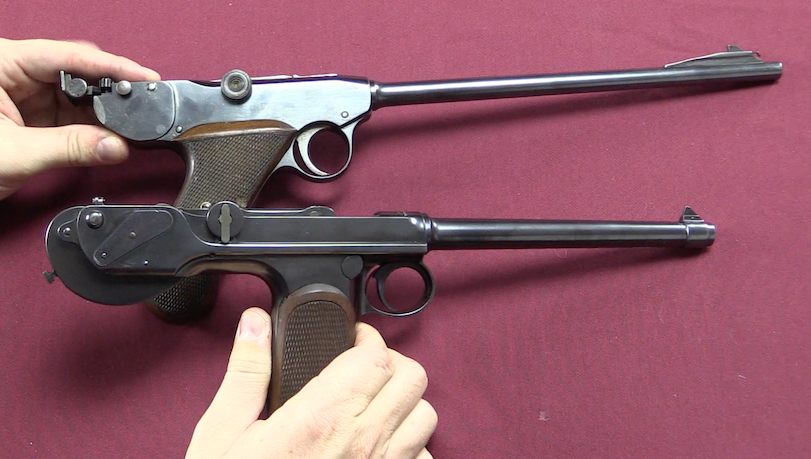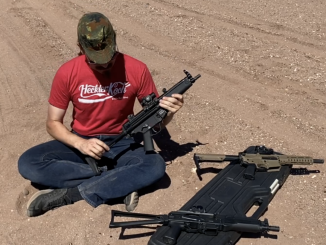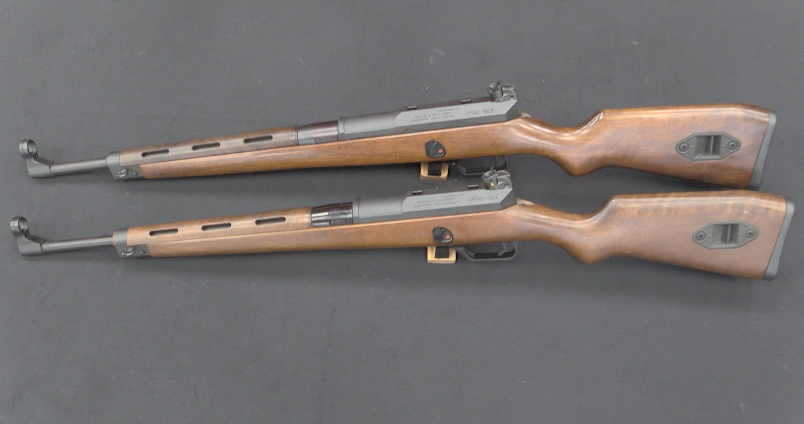The German military did not actually adopt the Mauser C96 “broom handle” before World War One. It was the first really successful semiauto pistol, but the German military chose the Luger instead, in 1908. However, as World War One continued, the German military realized it was going to be seriously short of handguns. The P08 Luger was a slow and expensive gun to produce, and so Germany went looking for alternatives. They would adopt a variety of .32 ACP caliber simple blowback pistols as substitute standards, but also took a new look at the C96. While the design was quite complex, Mauser still had all the tooling set up to produce them, and deliveries could begin relatively quickly.
In July 1917 the German military placed a contract for 200,000 C96 pistols, specifying that they be chambered for the 9mm Parabellum cartridge, instead of the 7.63mm Mauser cartridge the gun was originally designed for. In order to prevent ammunition mixups (as many existing 7.63mm Mausers had been brought into service as well) the new guns were to have large “9” numerals engraved in their grip and painted red – hence the colloquial name of the guns as “Red Nines”. The first deliveries were made in January of 1918, and would continue until the end of the war. Mauser was unable to completely fill the contract, and only about 95,000 were delivered by the end of the war, although production did continue post-war. These pistols are numbered in a new series starting at “1”, unrelated to the serial numbers of commercial Mauser pistols. Some, but not all, have a Prussian eagle marking on the front of the magazine. Total production after the war continued into the low 140,000 range.
The guns were all shipped with wooden holster/stock units and leather rigs to hold the pistol, holster, spare magazine spring and floor plate, and cleaning rod. The stocks were numbered to match the guns, and do not have the strap staple that was used on other commercial C96 stocks.
Thanks to Legacy Collectibles for providing me access to film these pistols! Check out their YouTube channel for lots of other interesting firearms history:
https://www.youtube.com/channel/UCesjdfSFVwNgqa299Bf3Zlw




WW2 Luftwaffe contract
The German government purchased 7,800 commercial M30 pistols in 1940 for use by the Luftwaffe. They have Wehrmacht proof marks and the Mauser serial numbers come from the early- to mid-1930s. The weapon had ceased production in 1937 but the order was filled from remaining stocks. According to Kersten, Moll and Schmid, these were likely purchased by the High Command of the Armed Forces and issued to motorcycle and flak crews of the Luftwaffe.
I have one.
[URL=https://imageshack.com/i/poJQWLDuj][IMG]https://imagizer.imageshack.com/v2/800x600q90/924/JQWLDu.jpg[/IMG][/URL]
[URL=https://imageshack.com/i/pnQNbcmxj][IMG]https://imagizer.imageshack.com/v2/800x600q90/923/QNbcmx.jpg[/IMG][/URL]
[URL=https://imageshack.com/i/pnlmmukMj][IMG]https://imagizer.imageshack.com/v2/800x600q90/923/lmmukM.jpg[/IMG][/URL]
[URL=https://imageshack.com/i/pmpxwZesj][IMG]https://imagizer.imageshack.com/v2/800x600q90/922/pxwZes.jpg[/IMG][/URL]
[URL=https://imageshack.com/i/pmwU9Z7Dj][IMG]https://imagizer.imageshack.com/v2/800x600q90/922/wU9Z7D.jpg[/IMG][/URL]
[URL=https://imageshack.com/i/pmB5KuDTj][IMG]https://imagizer.imageshack.com/v2/800x600q90/922/B5KuDT.jpg[/IMG][/URL]
What is the legal status (in the US) of a C96 with the holster stock attached? Does it have to be the gun’s original stock or is a reproduction ok? Many differing opinions on this question.
The combination of pistol and stock is counted as legal as long as the stock is original to the gun and not a replica. The C96 is classified as a relic, owing to age.
Not the case currently. Here’ s what the BATF says about C96 with repro shoulder sticks:
“ATF has previously determined that Mauser Model 1896 pistols with reproduction stocks, which duplicate or closely approximate the originals, have also been removed from the provisions of the NFA.”
The C96 was made in 9mmx25 Mauser Export before 1914, so the Red 9 contract was even easier.
Does anyone know why procurement continued after the war? Was it one of those weird contracts where it was cheaper for the government to keep buying something they didn’t need than to break the contract?
Were any Mauser C96 Red 9’s/9mm manufactured in Germany during the 1930’s?